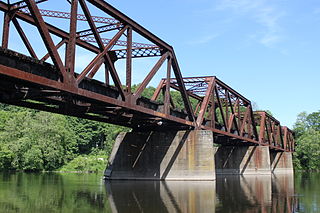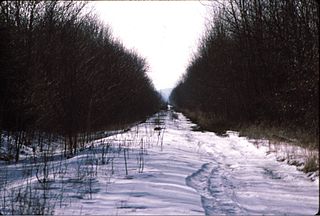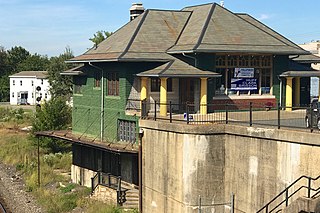
The Delaware, Lackawanna and Western Railroad, also known as the DL&W or Lackawanna Railroad, was a U.S. Class 1 railroad that connected Buffalo, New York, and Hoboken, New Jersey, and by ferry with New York City, a distance of 395 miles (636 km). The railroad was incorporated in Pennsylvania in 1853, and created primarily to provide a means of transport of anthracite coal from the Coal Region in Northeast Pennsylvania to large coal markets in New York City. The railroad gradually expanded both east and west, and eventually linked Buffalo with New York City.

The Erie Lackawanna Railway, known as the Erie Lackawanna Railroad until 1968, was formed from the 1960 merger of the Erie Railroad and the Delaware, Lackawanna & Western Railroad. The official motto of the line was "The Friendly Service Route".

NJ Transit Rail Operations is the rail division of NJ Transit. It operates commuter rail service in New Jersey, with most service centered on transportation to and from New York City, Hoboken, and Newark. NJ Transit also operates rail service in Orange and Rockland counties in New York under contract to Metro-North Railroad. The commuter rail lines saw 57,179,000 riders in 2023, making it the third-busiest commuter railroad in North America and the longest commuter rail system in North America by route length.

The Morristown Line is an NJ Transit commuter rail line connecting Morris and Essex counties to New York City, via either New York Penn Station or Hoboken Terminal. Out of 60 inbound and 58 outbound daily weekday trains, 28 inbound and 26 outbound Midtown Direct trains use the Kearny Connection to Penn Station; the rest go to Hoboken. Passengers can transfer at Newark Broad Street or Summit to reach the other destination. On rail system maps the line is colored dark green, and its symbol is a drum, a reference to Morristown's history during the American Revolution.

The Raritan Valley Line is a commuter rail service operated by New Jersey Transit (NJT) which serves passengers in municipalities in Union, Somerset, Middlesex, Essex and Hunterdon counties in the Raritan Valley region in central New Jersey, United States. The line's most frequent western terminus is Raritan station in Raritan. Some weekday trains continue farther west and terminate at the High Bridge station, located in High Bridge. Most eastbound trains terminate in Newark; passengers are able to transfer to NJ Transit using a combined ticket or PATH and Amtrak to New York City. A limited number of weekday trains continue directly to New York.

The Lehigh and Hudson River Railway (L&HR) was the smallest of the six railroads that were merged into Conrail in 1976. It was a bridge line running northeast–southwest across northwestern New Jersey, connecting the line to the Poughkeepsie Bridge at Maybrook, New York with Easton, Pennsylvania, where it interchanged with various other companies.
The Morris and Essex Railroad was a railroad across northern New Jersey, later part of the main line of the Delaware, Lackawanna and Western Railroad.

The Lackawanna Cut-Off was a rail line built by the Delaware, Lackawanna and Western Railroad (DL&W). Constructed from 1908 to 1911, the line was part of a 396-mile (637 km) main line between Hoboken, New Jersey, and Buffalo, New York. It ran west for 28.45 miles (45.79 km) from Port Morris Junction in Port Morris, New Jersey, near the south end of Lake Hopatcong about 45 miles (72 km) west-northwest of New York City, to Slateford Junction in Slateford, Pennsylvania near the Delaware Water Gap.

Netcong is an NJ Transit station in Netcong, in Morris County, New Jersey, United States. Located on Route 46 at Main Street in downtown Netcong, the small, 1-low level side platform station service passengers for the Morristown Line and the Montclair-Boonton Line. These lines provide service to Hoboken or to New York City via Midtown Direct on the Morristown Line at Dover station and Montclair-Boonton at Montclair State University station. Midtown Direct service can also be transferred at Newark Broad Street station in Newark. There is one track and one platform on the north side, adjacent to the station. NJ Transit maintains a substantial train servicing yard east of the Netcong station at Port Morris in Roxbury Township. Port Morris Yard is proposed to return as the junction of the Montclair-Boonton and Morristown lines for the Lackawanna Cut-Off line to Scranton. Transfers would be provided at Lake Hopatcong station in Landing.

Mount Olive is a NJ Transit station in Mount Olive, New Jersey, located in the International Trade Center. The station, located on the side of Waterloo Valley Road, services trains for both the Montclair-Boonton Line and the Morristown Line along trackage owned by Norfolk Southern. The line is not electrified from Hackettstown to Dover, where passengers can transfer to an electric Morristown Line train via Summit or a diesel Montclair-Boonton train via Wayne and Montclair. Trains along both lines head to Hoboken Terminal in Hoboken, New Jersey or New York Penn Station at 34th Street in New York City, although Montclair-Boonton trains require a transfer at Montclair State University or Newark Broad Street for electrified service to New York. It is also the least-used station in the NJ Transit commuter rail network.

Hackettstown is a New Jersey Transit station in Hackettstown, New Jersey. The station is located at the intersection of Valentine Street and Beatty Street and is the western terminus of the Morristown Line and the Montclair-Boonton Line, which both provide service to Hoboken Terminal or to Pennsylvania Station in Midtown Manhattan via Midtown Direct. Hackettstown station is the only active New Jersey Transit station in Warren County. The line from Hackettstown–Dover is diesel powered, requiring a transfer at Dover, Montclair State University or Newark Broad Street to an electrified train to New York Penn Station. Proposals exist of an extension of the Montclair-Boonton Line, including an extension to Washington and possibly Phillipsburg further along the Washington Secondary.

The Lackawanna Old Road was part of the original mainline of the Delaware, Lackawanna & Western Railroad (DL&W). Opened in 1856, it was, for a half-century, a part of the line connecting the states of New Jersey and Pennsylvania.

The Montclair-Boonton Line is a commuter rail line of New Jersey Transit Rail Operations in the United States. It is part of the Hoboken Division. The line is a consolidation of three individual lines: the former Delaware, Lackawanna & Western Railroad's Montclair Branch, which ran from Hoboken Terminal to Bay Street, Montclair. The Erie Railroad's Greenwood Lake Division, a segment from Montclair to Mountain View-Wayne, originally ran from the Jersey City Terminal to Greenwood Lake, NY, and the former Lackawanna Boonton Line ran from Hoboken to Hackettstown, New Jersey.

Port Morris Junction is the railroad connection between NJ Transit's Montclair-Boonton Line and the Lackawanna Cut-Off. Opened in 1911 by the Lackawanna Railroad, it is in the Port Morris, New Jersey section of Roxbury Township, New Jersey, south of Lake Hopatcong.

Roseville Tunnel is a 1,024-foot (312 m) two-track railroad tunnel on the Lackawanna Cut-Off in Byram Township, Sussex County, New Jersey. The tunnel is on a straight section of railroad between mileposts 51.6 and 51.8 (83 km), about 6 miles (9.7 km) north by northwest of Port Morris Junction. Operated for freight and passenger service from 1911 to 1979, it is undergoing work intended to return it to passenger service by 2026.

The Lackawanna Cut-Off Restoration Project is a New Jersey Transit and Amtrak effort to restore passenger service to the Lackawanna Cut-Off in northwest New Jersey.

Greendell is one of three original railway stations built by the Delaware, Lackawanna & Western Railroad (DL&W) along its Lackawanna Cut-Off line in northwestern New Jersey. The station, which still stands in Green Township at milepost 57.61 on the Cut-Off, began operations on December 23, 1911, one day before the line itself opened and the first revenue train arrived.

Andover is a planned New Jersey Transit passenger railroad station in Andover Township, in Sussex County, New Jersey, United States, providing service on its Lackawanna Cut-Off line. The line remains under construction. The station will be built at a site on Andover's Roseville Road, about 1.1 miles (1.8 km) from U.S. Route 206 and about 0.9 miles (1.4 km) from County Route 517. On the rail line, it will be located about 7.3 miles (11.7 km) west of Port Morris Junction.

Phillipsburg Union Station is an active railroad station museum, in Phillipsburg, New Jersey, United States, at 178 South Main Street. Opened in 1914, Union Station was built by the Delaware, Lackawanna & Western Railroad (DL&W) and shared with the Central Railroad of New Jersey (CNJ) and was situated where the lines merged before the bridge crossing the Delaware River. Designed by Frank J. Nies, the architect who produced many of DL&W stations now listed state and federal registers of historic places, the 2+1⁄2 story, 3 bay brick building is unusual example of a union station and a representation of early 20th century Prairie style architecture. The Phillipsburg Union Signal Tower, or PU Tower, is nearby, also restored to its original form, and available for tours.
The Washington Secondary is a freight-only railway line in the state of New Jersey. It runs 24.3 miles (39.1 km) from Phillipsburg, New Jersey, to Hackettstown, New Jersey. It forms a connection between the Lehigh Line and Morristown Line.























